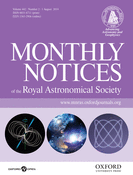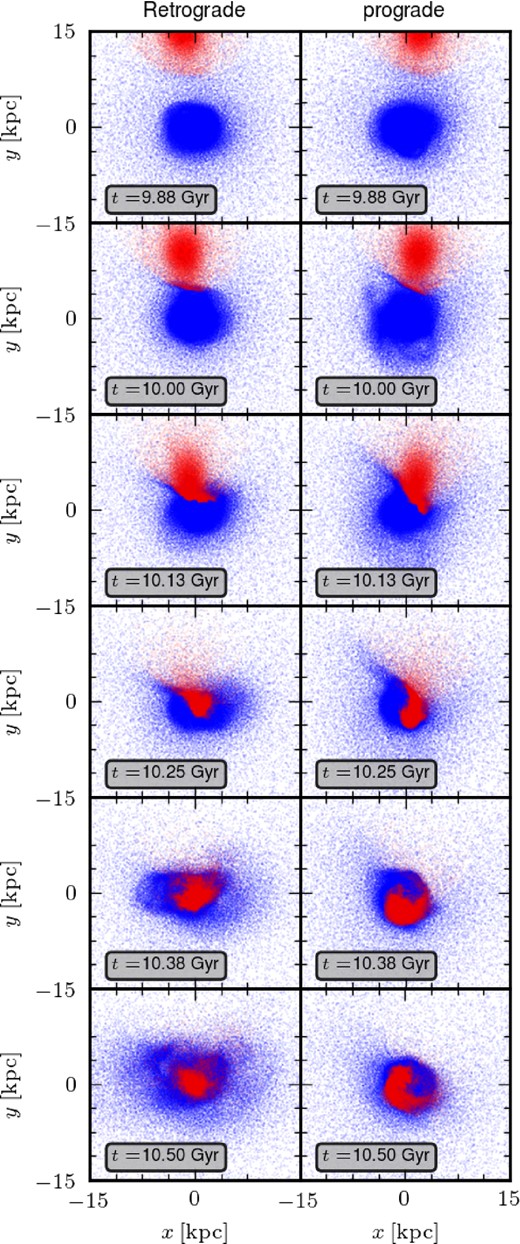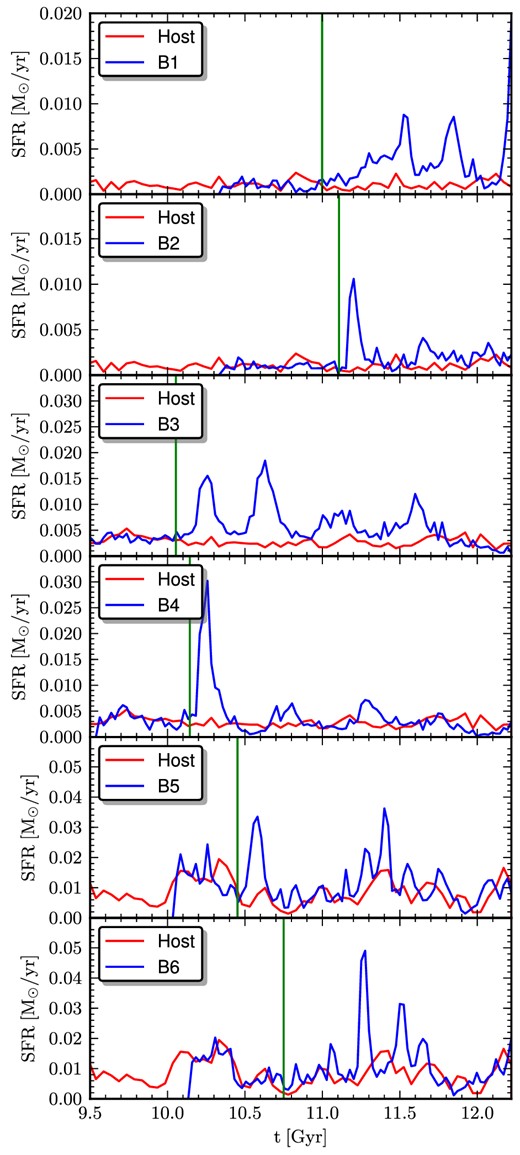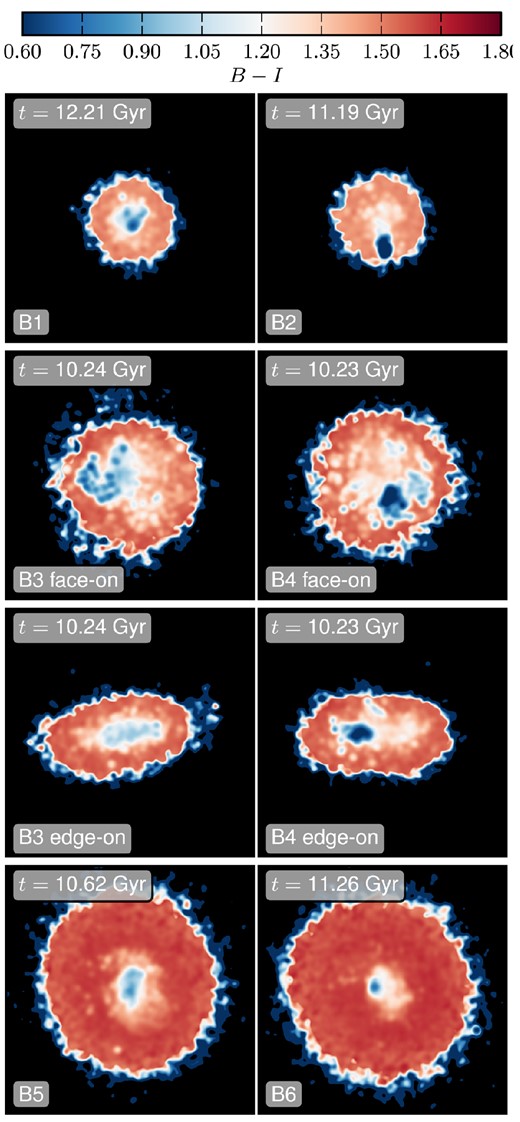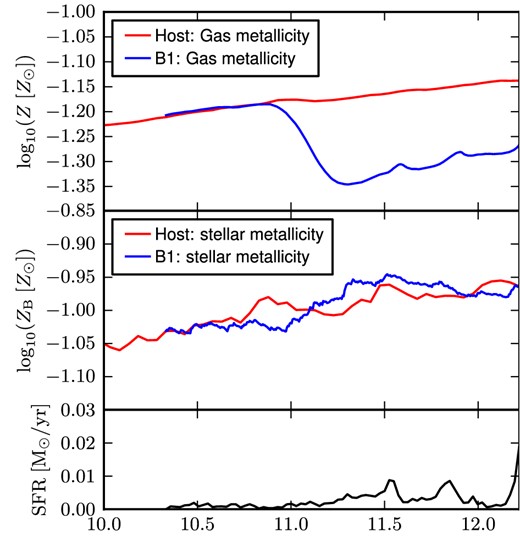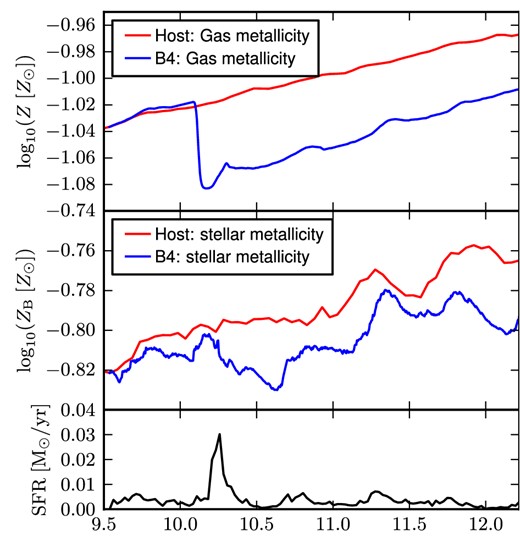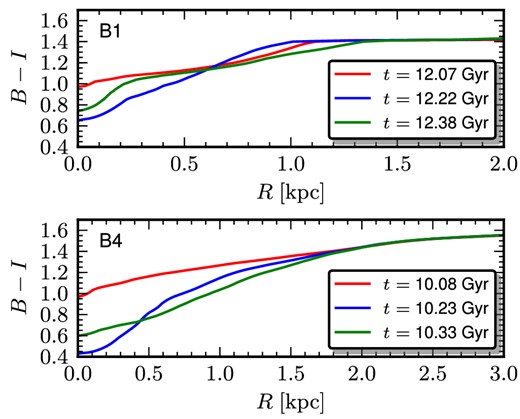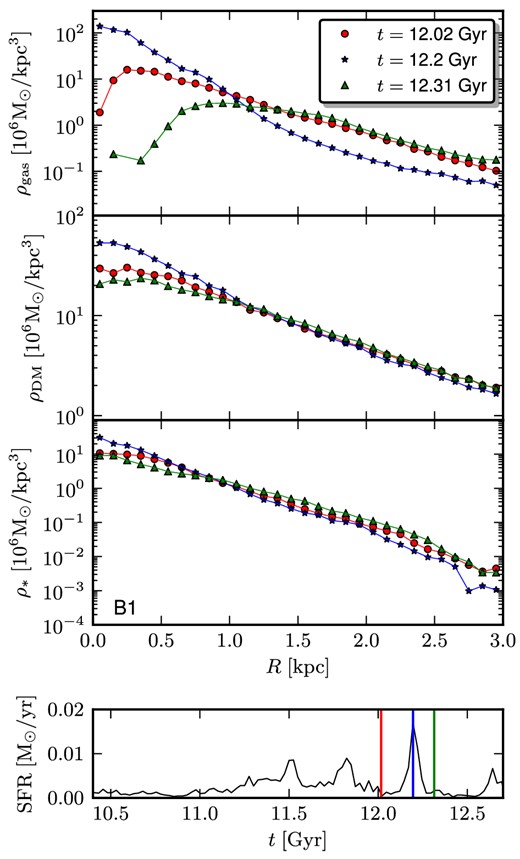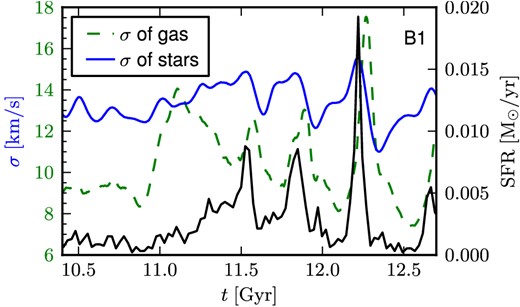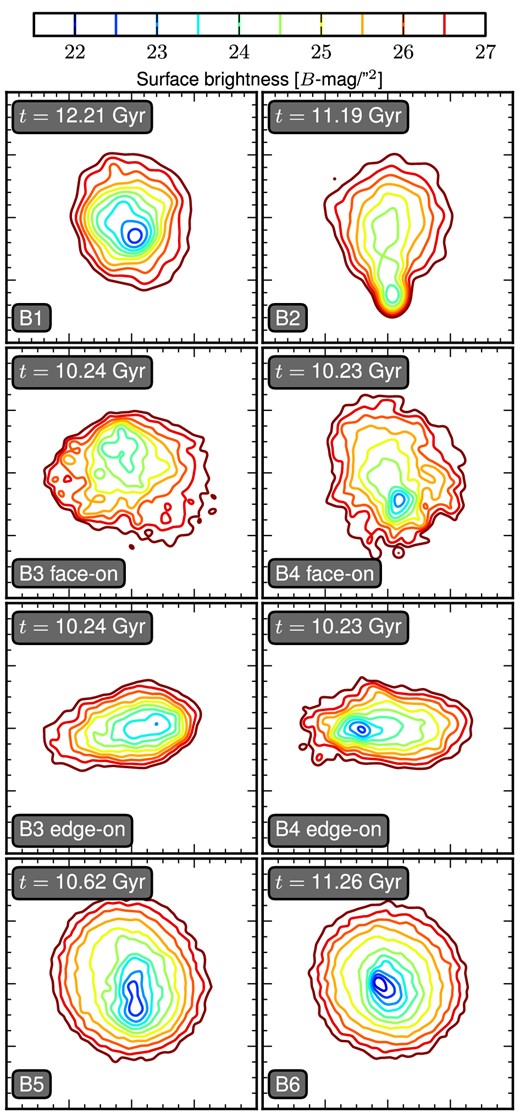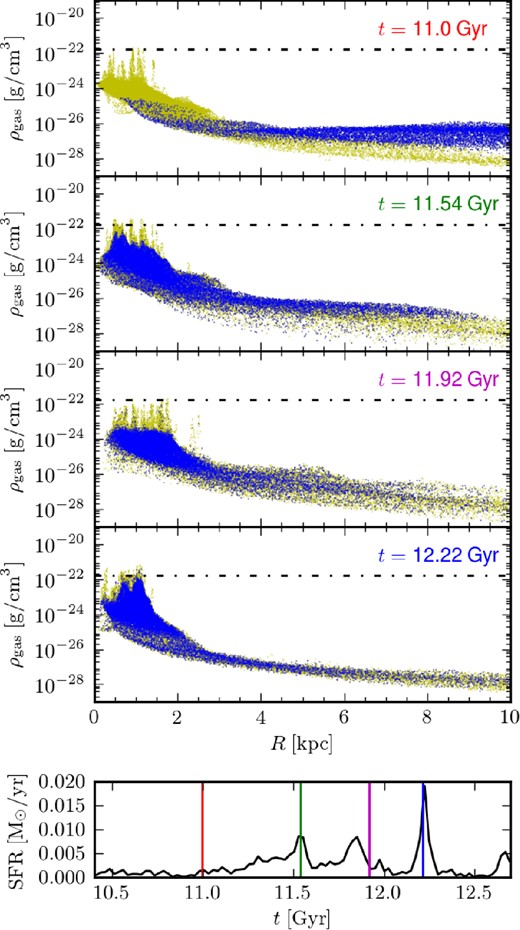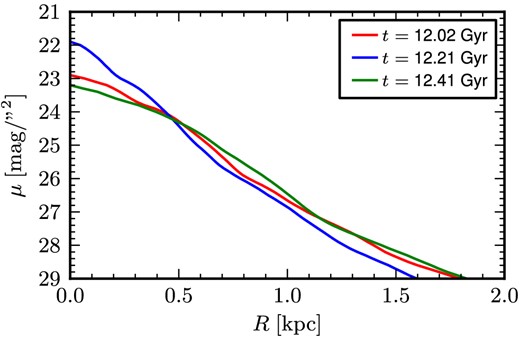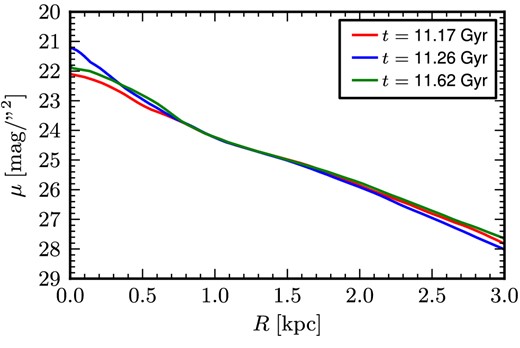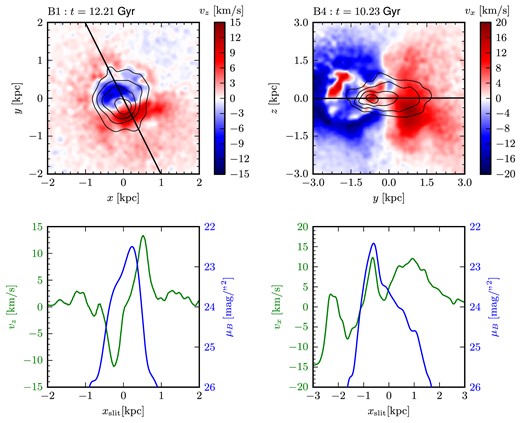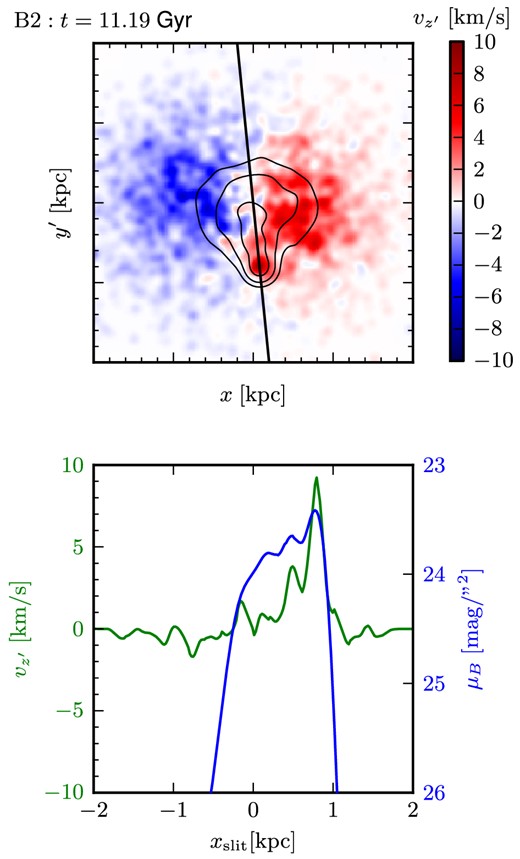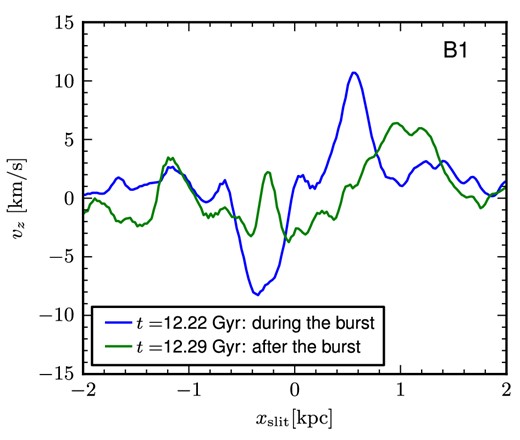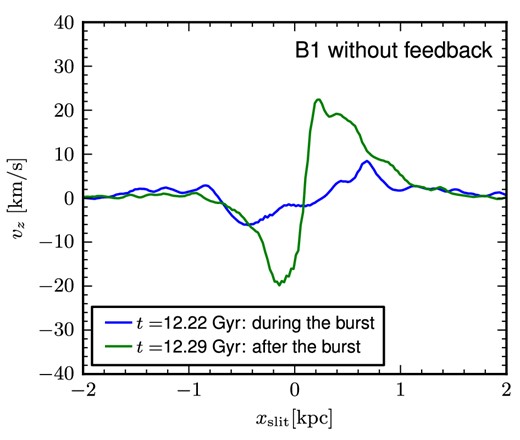-
PDF
- Split View
-
Views
-
Cite
Cite
R. Verbeke, S. De Rijcke, M. Koleva, A. Cloet-Osselaer, B. Vandenbroucke, J. Schroyen, Gaseous infall triggering starbursts in simulated dwarf galaxies, Monthly Notices of the Royal Astronomical Society, Volume 442, Issue 2, 1 August 2014, Pages 1830–1843, https://doi.org/10.1093/mnras/stu947
Close - Share Icon Share
Abstract
Using computer simulations, we explored gaseous infall as a possible explanation for the starburst phase in Blue Compact Dwarf galaxies. We simulate a cloud impact by merging a spherical gas cloud into an isolated dwarf galaxy. We investigated which conditions were favourable for triggering a burst and found that the orbit and the mass of the gas cloud play an important role. We discuss the metallicity, the kinematical properties, the internal dynamics and the gas, stellar and dark matter distribution of the simulations during a starburst. We find that these are in good agreement with observations and depending on the set-up (e.g. rotation of the host galaxy, radius of the gas cloud), our bursting galaxies can have qualitatively very different properties. Our simulations offer insight in how starbursts start and evolve. Based on this, we propose what postburst dwarf galaxies will look like.
1 INTRODUCTION
Blue Compact Dwarfs (BCDs) are dwarf galaxies which are currently undergoing an intense period of star formation. The exact classification requirements for a dwarf galaxy to be a BCD differ from author to author. Zwicky (1964) first coined the term compact, in order to classify objects that could only just be distinguished from stars on photographic plates. Thuan & Martin (1981) defined a BCD as a galaxy with low luminosity (MB ≥ −18 mag), with small optical sizes (≤1 kpc), and an optical spectrum that exhibits sharp narrow emission lines superposed on a blue continuum, which are both generally caused by a high star formation rate (SFR). This is the reason BCDs were initially thought to be young objects going through their first episode of star formation.
Deeper observations have shown that most BCDs in fact have a large population of old stars (Loose & Thuan 1986; Kunth, Maurogordato & Vigroux 1988; Papaderos et al. 1996a; Cairós et al. 2001). Loose & Thuan (1986) proposed a classification scheme based on the shape of the starburst region(s) and of the host galaxy.
i0 BCDs show no evidence of having a host galaxy and are candidates of being true young objects.
nE BCDs have a nucleated starburst component, embedded in a regular, elliptical host galaxy.
iE BCDs also have an elliptical host galaxy, but the starburst component is irregular.
iI BCDs have an irregular starburst embedded in an irregular host galaxy. This class can be further subdivided into
iI, C or cometary BCDs, which have very elongated host galaxies, with the star formation happening near one of the ends.
iI, M BCDs, which show clear signs of merging.
Based on surface brightness (SB) profiles, Papaderos et al. (1996b) and Salzer & Norton (1999) compared the structural parameters of BCD host galaxies to those of other dwarf galaxies and found that BCDs generally have smaller scale lengths and higher central SBs, meaning that their host galaxies are in general more compact than non-bursting dwarfs. Deeper observations have shown that the fainter, outer regions of BCDs (between 26 and 28 mag arcsec−2) do agree with dE/dIrr data (Micheva et al. 2013a), although this might not hold for fainter BCDs (Micheva et al. 2013b).
BCDs generally have a large central concentration of neutral gas (e.g. Taylor et al. 1994, 1995; van Zee, Skillman & Salzer 1998; Simpson & Gottesman 2000; Zhao, Gao & Gu 2013; Lelli, Verheijen & Fraternali 2014), although a variation in column density between different BCDs has been found (Simpson et al. 2011). It was found that their gas can have very steep rotation curves, suggesting their dark matter (DM) is centrally concentrated as well (e.g. van Zee, Salzer & Skillman 2001; Lelli et al. 2012a,b).
The gaseous metallicity of BCDs was found to generally be lower than that of dIs and dEs (e.g. Terlevich et al. 1991; Izotov, Thuan & Lipovetsky 1994; Izotov & Thuan 1999; Hunter & Hoffman 1999). Zhao et al. (2013) found that nE and iE BCDs are more metal-rich than iI BCDs, suggesting they might be at different evolutionary stages or have different progenitors.
Using an extended version of the Gadget-2N-body/SPH code, we can self-consistently simulate isolated dwarf galaxies (Valcke, De Rijcke & Dejonghe 2008; Schroyen et al. 2011, 2013; Cloet-Osselaer et al. 2012, 2014). In rotating models, the star formation is continuous while in the non-rotating dwarfs, we can find a SFR that goes up and down with a period of ∼108–109 years (see also Stinson et al. 2007; Revaz et al. 2009). However, even in this breathing star formation, we cannot identify true bursts.
Several external trigger mechanisms for the starburst in BCDs have been proposed and investigated. Tidal interaction could be the trigger (Brinks & Klein 1988; Brinks 1990; Campos-Aguilar & Moles 1991; Noeske et al. 2001), although not every BCD has a massive companion (Campos-Aguilar, Moles & Masegosa 1993; Telles & Terlevich 1995). Mergers between gas-rich dwarf galaxies have also been suggested (Östlin et al. 2001), which was confirmed as a plausible mechanism to trigger a starburst in simulated galaxies (Di Matteo et al. 2007; Bekki 2008; Cloet-Osselaer et al. 2014).
As not all BCDs show signs of merging or tidal interaction, several internal mechanisms have been proposed as well, which are not present in our simulation code. Elmegreen, Zhang & Hunter (2012) suggested in-spiralling clumps to drive DM, stars and gas from the halo towards the centre, which could feed the starburst. The stellar kinematics of BCDs can be very irregular, with the star-forming regions standing out as dynamically distinct entities (Koleva et al. 2014), suggesting they could be experiencing some form of interaction, even when galaxies seem to be in isolation. External gas infall has been suggested based on their high H i mass, disturbed and extended H i haloes and their low metallicities (Gordon & Gottesman 1981; Meier, Turner & Beck 2002; López-Sánchez et al. 2012; Sánchez Almeida et al. 2013; Zhao et al. 2013; Sánchez Almeida et al. 2014). H i clouds with no clear optical counterpart have been found around several BCDs (Taylor et al. 1994; Hoffman et al. 2003; Thuan, Hibbard & Lévrier 2004; Ramya, Kantharia & Prabhu 2009), so infall of such gas clouds is not an unlikely event.
In this paper, we shall use computer simulations to investigate whether a low metallicity gas cloud can trigger a starburst event in dwarf galaxies. This gas cloud can represent a truly external object or one that was formed within the galaxies halo.
An overview of the simulations we used is presented in Section 2. Section 3 gives an overview of our results, which are discussed in Section 4. We end with a summary in Section 5.
2 SIMULATIONS
A valuable way to understand the underling physics in galaxies is to run N-body/SPH simulations. When studying dwarf in particular, this is even more so since we can reach very high resolution for these low-mass objects. To the freely available N-body/SPH code Gadget-2 (Springel 2005), we added star formation, gas cooling and heating, chemical enrichment, and feedback (Valcke et al. 2008, 2010; Schroyen et al. 2011, 2013; Cloet-Osselaer et al. 2012; De Rijcke et al. 2013; Cloet-Osselaer et al. 2014). The simulations were then analysed using our own made analysis tool Hyplot, which is publically available1 and was used to produce all figures in this paper.
2.1 Initial conditions for the galaxy
The basic initial set up for our simulations is a halo of DM particles with gas particles added on top. We start the simulation at redshift z = 4.3 and let it evolve for a period of 12.22 Gyr, until z = 0. We employ a flat, Λ-dominated cosmology with cold dark matter, with h = 0.71, ΩM = 0.2383, ΩDM = 0.1967, Ωbaryon/ΩDM = 0.2115.
The bulk of our dwarf galaxy models have a DM halo of 2.5 × 109 M⊙ and an initial gas mass of 5.2 × 108 M⊙ (‘low-mass dwarf galaxy models’). This will result in a galaxy with −14 mag ≲ MB ≲ −12 mag at redshift z = 0, where models with higher rotation are more luminous. To see how our results translate to higher luminosities, we also set up galaxies with DM mass 1010 M⊙ and initial gas mass 2 × 109 M⊙ (‘high-mass dwarf galaxy models’), which will result in galaxies with MB ∼ −15 mag.
We used 2 × 105 DM and 2 × 105 gas particles for the low-mass models, resulting in DM and gas particles with masses of ∼12.5 × 103 M⊙ and ∼2.6 × 103 M⊙, respectively. 800 000 of each particle type were used for the high-mass models, giving roughly the same mass resolution.
2.2 Astrophysical prescriptions
Starting from these initial conditions, we can integrate the equations of motions, using our modified version of Gadget-2.
2.2.1 Radiative cooling
De Rijcke et al. (2013) calculated self-consistent metallicity-dependent cooling curves ranging from T = 10 K to T = 109 K. These are dependent on temperature, density, [Fe/H], and [Mg/Fe], which serve as tracers for the chemical enrichment by supernovae (SN) Type Ia and Type II, respectively. No UV background heating was concluded in the cooling curves we used.
2.2.2 Star formation
The convergence criterium (4) expresses that the gas is collapsing, the temperature criterium (5) expresses that the gas particle cannot have a temperature that is too high and the density criterium (6) ensures that the gas is dense enough. For ρcrit, the critical density, we use a high-density threshold (ρcrit = 100 amu cm−3) as it has been shown to provide a better prescription for star-forming regions (Governato et al. 2010; Schroyen et al. 2013). The density criterium is the strictest one, as gaseous regions will be unlikely to reach the critical density if they are too warm or not collapsing.
2.2.3 Feedback and chemical enrichment
The newly formed stellar particles are modelled with a Salpeter initial-mass function (Salpeter 1955). Young stellar particles give (thermal) feedback due to SN type II and stellar winds, while a delay of 1.5 Gyr is employed for SN type Ia feedback to start (Yoshii, Tsujimoto & Nomoto 1996). The energy output of both types of SN is 1051 erg and of stellar winds 1050 erg. The actual energy absorbed by the interstellar medium is determined by the feedback efficiency ϵFB. To produce sensible results, a high feedback efficiency is needed when using a high-density threshold and no UV background (Cloet-Osselaer et al. 2012). We chose ϵFB = 0.7. Along with the thermal energy from feedback, the gas particles are also enriched with metals produced in the stars and in SN.
As our simulations are not able to resolve the hot, low-density cavities blown by SN, a gas particle that is receiving stellar feedback is not allowed to cool radiatively during that time-step.
2.3 Gas clouds
To simulate a merger with a gas cloud, we first simulate a dwarf galaxy in isolation. Then, we introduce a gas cloud to the system at a certain time, a certain distance and with a certain velocity. We let it evolve until z = 0, allowing us to compare with observed BCDs at low redshift. While metallicity data exist for Milky Way HVCs, it is, at least to our knowledge, non-existent for gas clouds surrounding BCDs. Since BCDs are found predominantly in low-density environments such as the field, one would not expect gas clouds to have been significantly polluted. Therefore, the gas in the infalling gas cloud is initially given zero metallicity.
2.3.1 Mass
H i clouds with masses up to ∼107 M⊙ were found around BCDs (Hoffman et al. 2003; Thuan et al. 2004). For more estimates for the masses of infalling gas clouds, we could take a look at the masses of the high-velocity clouds (HVCs) around the Milky Way and other giant spirals as more data are available for these (e.g. Oosterloo, Fraternali & Sancisi 2007; Lehner, Staveley-Smith & Howk 2009; Putman et al. 2009). The H i masses of these HVCs are estimated to range between 104 M⊙ and 107 M⊙, but with great uncertainties on these masses because of the uncertain distances (van Woerden & Wakker 2004). A HVC with H i mass around 108 M⊙ has been found around M101, which most likely has a galactic origin (van der Hulst & Sancisi 1988), so unlikely to be found around BCDs.
Kereš & Hernquist (2009) performed computer simulations of the formation of these HVCs around a Milky Way sized halo. These produced gas clouds with total gas masses (both neutral and ionized) ranging from 106 M⊙ to several 107 M⊙, with the lower limit being an artefact of the low resolution of the simulation. The clouds in this simulation located at high distances from the galactic centre have a trend to also be the more massive ones.
Therefore, although a mass of ∼107 M⊙ is, admittedly, at the high end of the gas cloud mass distribution (Pisano et al. 2007), such massive clouds do exist. We expect that gas clouds with higher masses will have a bigger influence, so based on these observations and simulations, we will only discuss gas clouds with M ≈ 107 M⊙.
The density of the gas cloud is chosen to have a 1/r-profile.
2.3.2 Radius
The radius of a CGC we chose ad hoc, but significantly smaller than that obtained from equation (8). On the other hand, we also take it large enough to prevent that the density is too high and the gas cloud starts forming stars on its own. For CGCs we typically chose a radius of 2–3 kpc.
2.3.3 Temperature
2.3.4 Velocity
2.4 The models
Almost 150 simulations were run, all with variations in their set-up. The parameters that yield the biggest qualitative difference in the produced burst are the rotation rate of the host galaxy, the mass of the host and the radius of the gas cloud falling in. In this paper, we will explicitly discuss six different simulations, in which these effects are very clear.
B1 is a low-mass, slowly rotating host galaxy on to which an EGC falls in.
B2 has the same host as B1, but a CGC is falling in.
B3 is a low-mass host with fast rotation and an EGC falling in.
B4 has the same host galaxy as B3, but with a CGC falling in.
B5 is a high-mass host and an EGC falling in.
B6 has a high-mass host galaxy, but with a CGC falling in.
Table 1 gives a more detailed overview of the properties of the different models.
Columns indicate (1) model name, (2) DM mass of the host galaxy, (3) gas mass of the host galaxy, (4) the maximal rotational velocity, (5) the mass of the gas cloud, (6) the type of gas cloud (E – extended or C – compact), (7) the radius of the gas cloud, (8) the time the gas cloud is introduced to the system, (9) the initial position of the gas cloud, (10) the initial velocity of the gas cloud, (11) the peak SFR for the merger simulation, (12) the burst factor (the peak in SFR divided by the SFR of the host galaxy in isolation, averaged over 3 Gyr).
| Name . | Mhost,DM . | Mhost,g . | vmax . | MGC . | E/CGC . | RGC . | tinit . | (x, y, z) . | (vx, vy, vz) . | SFRpeak . | b . |
|---|---|---|---|---|---|---|---|---|---|---|---|
| . | [1010 M⊙] . | [1010 M⊙] . | [km s−1] . | [106 M⊙] . | . | [kpc] . | [Gyr] . | [kpc] . | [km s−1] . | [10−2 M⊙/yr] . | . |
| B1 | 0.25 | 0.052 | 1.0 | 52 | E | 7.5 | 10.33 | (−1,30,0) | (0,−25,0) | 1.9 | 17.67 |
| B2 | 0.25 | 0.052 | 1.0 | 42 | C | 2.0 | 10.33 | (−1,30,0) | (0,−25,0) | 1.1 | 9.73 |
| B3 | 0.25 | 0.052 | 5.0 | 52 | E | 7.5 | 9.39 | (−2,30,0) | (0,−25,0) | 1.8 | 6.54 |
| B4 | 0.25 | 0.052 | 5.0 | 42 | C | 2.0 | 9.54 | (−2,30,0) | (0,−35,0) | 3.0 | 10.71 |
| B5 | 1 | 0.21 | 2.5 | 52 | E | 7.5 | 10.03 | (−1,30,0) | (0,−45,0) | 3.6 | 3.81 |
| B6 | 1 | 0.21 | 2.5 | 42 | C | 3.0 | 10.13 | (−2,30,0) | (0,−20,0) | 4.9 | 5.16 |
| Name . | Mhost,DM . | Mhost,g . | vmax . | MGC . | E/CGC . | RGC . | tinit . | (x, y, z) . | (vx, vy, vz) . | SFRpeak . | b . |
|---|---|---|---|---|---|---|---|---|---|---|---|
| . | [1010 M⊙] . | [1010 M⊙] . | [km s−1] . | [106 M⊙] . | . | [kpc] . | [Gyr] . | [kpc] . | [km s−1] . | [10−2 M⊙/yr] . | . |
| B1 | 0.25 | 0.052 | 1.0 | 52 | E | 7.5 | 10.33 | (−1,30,0) | (0,−25,0) | 1.9 | 17.67 |
| B2 | 0.25 | 0.052 | 1.0 | 42 | C | 2.0 | 10.33 | (−1,30,0) | (0,−25,0) | 1.1 | 9.73 |
| B3 | 0.25 | 0.052 | 5.0 | 52 | E | 7.5 | 9.39 | (−2,30,0) | (0,−25,0) | 1.8 | 6.54 |
| B4 | 0.25 | 0.052 | 5.0 | 42 | C | 2.0 | 9.54 | (−2,30,0) | (0,−35,0) | 3.0 | 10.71 |
| B5 | 1 | 0.21 | 2.5 | 52 | E | 7.5 | 10.03 | (−1,30,0) | (0,−45,0) | 3.6 | 3.81 |
| B6 | 1 | 0.21 | 2.5 | 42 | C | 3.0 | 10.13 | (−2,30,0) | (0,−20,0) | 4.9 | 5.16 |
Columns indicate (1) model name, (2) DM mass of the host galaxy, (3) gas mass of the host galaxy, (4) the maximal rotational velocity, (5) the mass of the gas cloud, (6) the type of gas cloud (E – extended or C – compact), (7) the radius of the gas cloud, (8) the time the gas cloud is introduced to the system, (9) the initial position of the gas cloud, (10) the initial velocity of the gas cloud, (11) the peak SFR for the merger simulation, (12) the burst factor (the peak in SFR divided by the SFR of the host galaxy in isolation, averaged over 3 Gyr).
| Name . | Mhost,DM . | Mhost,g . | vmax . | MGC . | E/CGC . | RGC . | tinit . | (x, y, z) . | (vx, vy, vz) . | SFRpeak . | b . |
|---|---|---|---|---|---|---|---|---|---|---|---|
| . | [1010 M⊙] . | [1010 M⊙] . | [km s−1] . | [106 M⊙] . | . | [kpc] . | [Gyr] . | [kpc] . | [km s−1] . | [10−2 M⊙/yr] . | . |
| B1 | 0.25 | 0.052 | 1.0 | 52 | E | 7.5 | 10.33 | (−1,30,0) | (0,−25,0) | 1.9 | 17.67 |
| B2 | 0.25 | 0.052 | 1.0 | 42 | C | 2.0 | 10.33 | (−1,30,0) | (0,−25,0) | 1.1 | 9.73 |
| B3 | 0.25 | 0.052 | 5.0 | 52 | E | 7.5 | 9.39 | (−2,30,0) | (0,−25,0) | 1.8 | 6.54 |
| B4 | 0.25 | 0.052 | 5.0 | 42 | C | 2.0 | 9.54 | (−2,30,0) | (0,−35,0) | 3.0 | 10.71 |
| B5 | 1 | 0.21 | 2.5 | 52 | E | 7.5 | 10.03 | (−1,30,0) | (0,−45,0) | 3.6 | 3.81 |
| B6 | 1 | 0.21 | 2.5 | 42 | C | 3.0 | 10.13 | (−2,30,0) | (0,−20,0) | 4.9 | 5.16 |
| Name . | Mhost,DM . | Mhost,g . | vmax . | MGC . | E/CGC . | RGC . | tinit . | (x, y, z) . | (vx, vy, vz) . | SFRpeak . | b . |
|---|---|---|---|---|---|---|---|---|---|---|---|
| . | [1010 M⊙] . | [1010 M⊙] . | [km s−1] . | [106 M⊙] . | . | [kpc] . | [Gyr] . | [kpc] . | [km s−1] . | [10−2 M⊙/yr] . | . |
| B1 | 0.25 | 0.052 | 1.0 | 52 | E | 7.5 | 10.33 | (−1,30,0) | (0,−25,0) | 1.9 | 17.67 |
| B2 | 0.25 | 0.052 | 1.0 | 42 | C | 2.0 | 10.33 | (−1,30,0) | (0,−25,0) | 1.1 | 9.73 |
| B3 | 0.25 | 0.052 | 5.0 | 52 | E | 7.5 | 9.39 | (−2,30,0) | (0,−25,0) | 1.8 | 6.54 |
| B4 | 0.25 | 0.052 | 5.0 | 42 | C | 2.0 | 9.54 | (−2,30,0) | (0,−35,0) | 3.0 | 10.71 |
| B5 | 1 | 0.21 | 2.5 | 52 | E | 7.5 | 10.03 | (−1,30,0) | (0,−45,0) | 3.6 | 3.81 |
| B6 | 1 | 0.21 | 2.5 | 42 | C | 3.0 | 10.13 | (−2,30,0) | (0,−20,0) | 4.9 | 5.16 |
Other variations were explored, like the initial velocity of the gas cloud or the trajectory along which it falls in. These are not discussed explicitly using different models, but their results will be discussed where relevant in Section 3.
3 RESULTS
3.1 Statistics
In total, 143 simulations were run. Out of these, 73 (∼50 per cent) had a burst, of which nine were strong bursts. However, we can divide our simulations in several groups depending on the set-up, to distinguish several determining effects.
17 of the total simulation sample used a gas cloud with M < 107 M⊙, of which none produced a burst.
In eight of the remaining simulations, the gas cloud fell in along a prograde orbit, while in the others a retrograde orbit or a face-on collision was used. In only one of the former, a burst could be found. After close inspection of this simulation, we found that the reason for the burst was that the gas cloud already had a high density on its own, out of which a large amount of stars could be formed when the gas cloud was moving through a deep gravitational potential and a high-density region.
Of the remaining 118 simulations, 22 were high-mass models and 96 were low-mass models. Five (∼20 per cent) of the high-mass models had a burst (of which none was strong bursts), while 67 (∼70 per cent) of the low-mass models had a burst (out of which eight were strong bursts).
We do not wish to over-interpret these statistics, as they are not independent (e.g. several share the same host galaxy), but we can draw some general conclusions.
We need a gas cloud with M ≳ 107 M⊙ to trigger a burst in our models.
Gas clouds falling in on a prograde orbit are unlikely to trigger a burst.
For a gas cloud with the same mass, higher mass galaxies will be less likely to undergo a burst.
3.2 Gaseous infall and starburst modes
Gaseous infall can trigger enhanced star formation in a galaxy in several ways. This can be seen from Fig. 1, where we show the SFR in function of time of our six models (black, blue in the online colour version), compared to that of their host galaxies in isolation (grey, red in the online colour version). The vertical lines roughly show the moments the gas cloud enters the system.
When a very EGC is falling in on a slowly or non-rotating host galaxy, it can compress the gas of the host out of which stars will be born (B5). However, this will not necessarily happen and we might not find a starburst initially. However, all the gas of the host galaxy will be affected, making it more turbulent and more likely to collapse, resulting in a strong burst at later times (B1).
In the case of a rotating galaxy (B3), the story is mainly the same, except that the direction the gas cloud is falling in from is important as it was concluded in Section 3.1. In a retrograde merger, the two gas reservoirs collide and lots of gas is driven towards the galaxy centre. This is clear in the left column of Fig. 2. In a prograde merger, the velocities of the two gas reservoirs closely match and the infalling gas cloud swirls around the galaxy centre. There is no significant angular momentum exchange between both gas reservoirs, no gas is driven towards the galaxy centre, and no starburst is ignited. Movies of this can be found on our Youtube channel.2
Gaseous infall on a dwarf galaxy. Black points (red in the online colour version) show the gas cloud falling in; grey points (blue in the online colour version) represent the gas of the dwarf galaxy. The left panels show the set-up of B3: a gas cloud falling in on a dwarf galaxy along a retrograde trajectory. The right panel shows the same set-up, but with the initial position of the gas cloud at (2, 30, 0), resulting in a prograde trajectory.
For the high-mass models, these results remain valid, but since we use a gas cloud of the same mass as in the low-mass models, the gas of the galaxy will be less disturbed in this case.
On the other hand, when we use a CGC, the gas cloud will only have an effect very locally. When stars are being formed as a direct consequence of the gas cloud impact, they will be formed along the path of the gas cloud. This is the case in B2 and B4. In the absence of rotation, the host galaxy will not be able to efficiently stop the gas cloud, so star-forming region will have an elongated shape. Rotating galaxies will be able to stop it more efficiently, resulting in a more centralized star-forming region.
In B6, the CGC did not immediately trigger an increased SFR. Rather, most of the gas flew through the galaxy, since the gas cloud has been significantly accelerated by the high-mass dwarf galaxy. Shortly after, however, the gas falls back, triggering the burst. The starburst is more centralized compared to B2 and B4 since the gas falling back in now has low densities. Thus the stars will be formed out of the old gas of the galaxy, much like the simulations with EGCs.
Fig. 3 shows B − I colour images of our models, illustrating these effects. These images were obtained by setting up Cartesian luminosity grids in both bands, to which we applied a Gaussian filter (with σ = 100 pc) to produce smoother images. The SB of grid cells fainter than 29 mag arcsec−2 were put to this magnitude. The blue edges are an artefact of this truncation, since the B band will be rounded off more quickly than the I band, so B − I is underestimated.
3.3 Duration and periodicity of the starburst
After the initial burst, feedback in the form of SNII and stellar winds will efficiently remove the central gas reservoir and shut down the burst. Our bursts have lifetimes of a couple of 100 Myr, with a trend of stronger bursts having shorter lifetimes since the feedback will be more intense and remove the gas more efficiently. Indeed, in simulation B1 (top panel of Fig. 1) we can identify a period of high star formation lasting ∼1 Gyr, shortly followed by a strong but short burst.
SFR of bursting galaxies (black, blue in the online colour version), compared to that of their host galaxy in isolation (grey, red in the online colour version). The models are the ones from Table 1. Vertical lines roughly indicate when the gas cloud falls in on the dwarf galaxy.
After the burst, we have little gas in the centre of the galaxy, making it easy for the gas to fall back in and produce secondary bursts. We find these subsequent bursts in simulations B1, B3, B5 and B6, as can be seen in Fig. 1.
3.4 Strength of the burst
The mass of the gas cloud plays an important role in the strength of the burst. The more massive it is, the stronger the burst it can trigger. A gas cloud with M = 5 × 107 M⊙ can temporarily increase the SFR with a factor of 20 in the low-mass dwarf galaxy models.
For gas clouds of the same mass, the increase in SFR will be less significant in more massive dwarfs. These dwarf galaxies are already forming stars at higher rates because of the higher gas content and deeper gravitational potential, making it harder to get a relative increase in SFR similar to that in the less massive dwarf galaxy models. The more massive dwarfs will still have an increased SFR during the burst.
The peak in SFR of each model and the burstfactor b, which is the relative increase compared to the average SFR of the host over the last 3 Gyr, are given in Columns 11 and 12 in Table 1.
Secondary bursts can be stronger than the initial burst (e.g. B1) but generally, we can expect the strength of each subsequent burst to be lower than the previous one.
3.5 Metallicity
It is to be expected that the metallicity of the dwarf galaxy will drop when we let a metal-poor gas cloud merge with it. In all our models, we found that the metallicity of the gas within 5 kpc of the dwarf galaxy centre indeed drops significantly when the gas cloud enters the system. We show the evolution of the gaseous metallicity in the top panels of Figs 4 and 5 for B1 and B4, respectively.
However, looking at the B-band luminosity weighted metallicity of the stars (middle panel of Fig. 4), we see that the metallicity can increase significantly following the merger. In fact, the only ones of the models discussed here where the metallicity drops are model B2 and B4, as can be seen in Fig. 5 for the latter.
In the other models, the gas falling in will not reach high enough densities to form stars at initial impact so if there is an immediate starburst (e.g. B5), the stars will be formed out of the old, metal-enriched gas. In the case of bursts arising from the disturbed gas (e.g. B1), the gas will be well mixed and stars will be formed out of metal-enriched gas as well. In B2 and B4, on the contrary, a significant part of the starburst is consuming the new, metal-poor gas.
3.6 Colour
Given the presence of irregular star formation knots in our galaxies during the starburst, we obtain colour profiles using a technique similar to isophotal integration for obtaining SB profiles (Papaderos et al. 1996a; Micheva et al. 2013a,b). We start from the Cartesian grids used to produce the B − I colour maps in Fig. 3. For each colour value, we determine the number of grid cells with colours bluer than this value and add their areas together. These areas are then converted to the equivalent radius of a circle with the same area. This method gives the radius in function of colour and it will produce a monotonically rising profile. The employed technique comes with the caveat that at some point, grid cells containing no stellar particles start influencing the profile. We cut off our profile before this happens. Also, the obtained radius cannot be interpreted as a physical distance from the centre of the galaxy, unless in regular circular or elliptical systems.
B − I colour maps of our models during their bursts. All figures show 10 kpc in both directions.
Evolution of the metallicity of the gas within 5 kpc (top panel), the B-band luminosity weighted metallicity of the stars (middle panel) and the SFR (bottom panel) of simulation B1. Grey (red in the online colour version) shows the model in isolation, and black (blue in the online colour version) shows what happens when a gas cloud falls in.
The result for B1 and B4 can be seen in Fig. 6, in which the colour profiles before (light grey, red in the online colour version), during (black, blue in the online colour version) and after (grey, green in the online colour version) their respective bursts are shown. We note that B1 has a strong burst right at the end of the simulation (top panel of Fig. 1). To investigate what happens after the burst, we continued this simulation until t = 12.7 Gyr. For this simulation, we see a clear drop in colour for R ≲ 1 kpc during the burst, with colour difference of over 0.3 mag in the centre, compared to before the burst. After the burst, the galaxy has become redder in the centre than during the burst, but is still bluer than before the burst. For R ≳ 0.5 kpc, the post-burst galaxy is bluer than during the burst. This can be due to recently formed stars moving to higher radii or stars being formed by the intense feedback following the central starburst. Since the stars are being formed from the metal-enriched gas of the dwarf galaxy, the bluer colours can be solely attributed by the age of the stellar population. For B4, the trend is the same, but we find much bluer colours: B − I drops by ∼0.6 mag in the centre, compared to before the burst. The reason is that now the stars are being formed from the metal-poor gas of the gas cloud.
B − I colour profile of model B1 (top) and B4 (bottom) before (light grey, red in the online colour version), during (black, blue in the online colour version) and after (grey, green in the online colour version) their respective bursts.
3.7 Density profiles
Fig. 7 shows the density profile of the gas, DM and stars, at times before (light grey circles, red in the online colour version), during (black stars, blue in the online colour version) and after the burst (grey triangles, green in the online colour version). We see that for all the components, the central density rises significantly during the burst compared to before, while the density at higher radii drops. After the burst, the central density drops, even below the density before the burst, and gets higher in the outer regions. This effect is strongest for the gas.
Gas, DM and stellar density profile of B1 before (light grey circles, red in the online colour version), during (black stars, blue in the online colour version) and after the starburst event (grey triangles, green in the online colour version).
No matter how the starburst is triggered exactly, the reason we have a burst is because the gas reaches a high density in a certain area. So the higher central gaseous densities should not come as a surprise. However, this large central gaseous mass causes the rest of the galaxy to contract. Hence we get a more compact galaxy, with a higher concentration of gas, DM and stars in the centre (also because of the high star formation) and a lower concentration in the outskirts of the galaxy. This redistribution of matter can in other words be attributed to the deepening of the gravitational potential. This process occurs in all models, albeit less significant in B2 and B4, where the impact of the CGC is a more local effect.
Shortly after the burst, the gas will receive a lot of feedback from the young stellar particles and will be blown to larger radii. The gravitational potential becomes shallower and the DM and stars also move outwards, resulting in a more diffuse galaxy. This process is present in all models and should be only dependent on the strength of the burst, as this determines the amount of feedback and thus the efficiency of the removal of the gas.
Since the expansion due to feedback will be faster than the previous collapse to the centre, the former will have a larger effect. So we are possibly left with a postburst galaxy that is more diffuse than preburst.
3.8 Velocity dispersion
In Fig. 8, we show the evolution of σ of the gas and of the stars of B1, along with the SFR. When the gas enters the system (at ∼ 11 Gyr), the velocity dispersion of the gas increases significantly. After it drops back, it follows the general trend of the SFR with a slight delay. The velocity dispersion of the stars increases and decreases together with the SFR. This trend is present in all our models, albeit less significant in the more massive ones B5 and B6.
Velocity dispersion of the gas (grey dashed line, green in the online colour version) and of the stars (light grey solid line, blue in the online colour version) compared to the SFR (black solid line) for simulation B1.
Before the gas can form stars, it has to cool down and collapse, thus lowering its velocity dispersion. As new stars are being formed, gas with low σ is removed and, more importantly, the surrounding gas gets heated and it expands, increasing the gaseous velocity dispersion. This explains why the velocity dispersion of the gas follows the SFR with a slight delay.
On the other hand, as the gas collapses and produces a burst, the stellar body also becomes more compact and the velocity dispersion of the stars increases during a starburst.
Shortly after the burst, the stellar body is more diffuse and the velocity dispersion drops. This explains the concurrence of the stellar velocity dispersion curve and the SFR in Fig. 8. The same is true for the DM. As an extra effect, we have a lot of young stars with low σ, further decreasing the velocity dispersion of the stars.
3.9 Isophotal maps
Fig. 9 shows the isophotal maps of our models during their strongest peak in star formation. To obtain these, we produced a Cartesian grid (with cells of width 70 pc), calculated the SB in each cell, applied a Gaussian filter (σ = 100 pc) to smooth the data and plotted the contours. Isophotes go from μ = 27 mag arcsec−2 (most outer and faintest, reddest in the online colour version) up to μ = 21.5 mag arcsec−2 (most inner and darkest, bluest in the online colour version), in increments of 0.5 mag arcsec−2.
Isophotal maps in the B band of our models during their burst. Sides for B1 and B2 are 4 kpc on both sides, for B3 and B4 6 kpc and for B5 and B6 both sides are 7 kpc. For B3 and B4, the models with a strongly rotating host galaxy, both the edge-on as the face-on maps are shown. Isophotes go from μ = 27 mag arcsec−2 (most outer and faintest, reddest in the online colour version) up to μ = 21.5 mag arcsec−2 (most inner and darkest, bluest in the online colour version), in increments of 0.5 mag arcsec−2
Model B1 has a regular, slightly off-centre star-forming region and the outer isophotes are nicely elliptical. Model B2 has a very off-centre star-forming region, giving the entire galaxy a very elongated shape.
For B3 and B4, the models with a host with strong rotation, we show both a face-on and edge-on view. Face-on, both have very irregular outer isophotes, which can be explained by the rotation (Schroyen et al. 2011). The star-forming region in both models is very off-centre. In B3, it is very irregular, while the star-forming region in B4 is more regular. However, due to it being off-centre, it also gives the galaxy an elongated shape.
Edge-on, the outer isophotes are flattened and more regular. In B3, the star-forming region is off-centre and slightly irregular, while in B4, it is very centralized.
Both the high-mass models B5 and B6 show a regular, slightly off-centre star-forming region embedded in an elliptical host galaxy.
4 DISCUSSION
4.1 The triggering mechanism
Having established that an infalling gas cloud can trigger a significant increase in the star formation of a dwarf galaxy, we can wonder what exactly is the reason of this increase. In Fig. 10, we show the radius and density of all gas particles in simulation B1 at different times. The gas already present in the dwarf galaxy is shown by black dots (yellow in the online colour version), while the grey dots (blue in the online colour version) represent the newly added gas of the gas cloud. The first panel (t = 11 Gyr) shows the EGC falling in. In the second panel (t = 11.54 Gyr), the influx of gas has led to the formation of many star-forming clouds and consequently to an increased SFR. Remarkably, virtually no ‘new’ gas particles are mixed into these high-density, star-forming regions and the stars are being formed out of the ‘old’ gas of the galaxy. This causes the stellar metallicity to further increase (Section 3.5). Clearly, this first sharp increase of the SFR is the direct result of the gas cloud compressing the old gas of the galaxy. This initial increase in SFR when the gas cloud enters the system can be seen in all our models, except in B6. On the other hand, when the gas cloud is initially dense enough, stars can form out of the new gas, resulting in a more metal-poor starburst. This occurs in simulations B2 and B4.
Scatter plot of the density and radius of all gas particles of simulation B1. Black points (yellow in the online colour version) represent the old gas of the dwarf galaxy, and grey points (blue in the online colour version) show the infalling gas cloud. The dash–dotted line shows the density threshold for star formation.
Moreover, we can conclude from our simulations that gas cloud mergers also have a longer lasting impact on the SFR. The increased turbulence of the interstellar gas following a merger and starburst lasts for several Gyr, as can be seen in the velocity dispersion of the gas (Section 3.8). During this time, the gas appears to be much more prone to gravitational collapse and therefore to subsequent starburst events. In the third panel (t = 11.92 Gyr) of Fig. 10, the feedback following the previous star formation has blown out the gas from the central region, lowering the SFR. Around R ∼ 5 kpc, for instance, one can see this gas being blown out. In the fourth panel (t = 12.22 Gyr), the gas has fallen back in and a starburst ensues, over a gigayear after the merger. Now, the gas is well mixed and the stars are being formed out of both the old and the newly added gas.
4.2 Surface brightness profile
As shown in Section 3.7, the stellar body of the galaxy becomes more compact during a starburst, in agreement with e.g. Papaderos et al. (1996a) and Micheva et al. (2013a,b). They draw their conclusions by investigating the SB profiles, usually obtained using isophotal integration due to the possible irregular shapes of BCDs. This method was already used to produce the colour profiles in Section 3.6, and now we obtain SB profiles in a similar way. Figs 11 and 12 show the B-band SB for models B1 and B6, respectively, before (light grey, red in the online colour version), during (black, blue in the online colour version) and after (dark grey, green in the online colour version) the starburst.
Isophotal SB profile in the B band before (light grey, red in the online colour version), during (black, blue in the online colour version) and after (dark grey, green in the online colour version) the starburst in simulation B1.
For the strong burst in B1 at t ≈ 12.2 Gyr, we find an increase in SB in the centre, by about 1 mag arcsec−2, due to the bright, newly formed stellar populations. Moreover, as shown in Section 3.7, the outer stars are moving inwards causing the SB outside the inner ∼0.5 kpc to decrease. This results in an overall steeper surface brightness profile. For the more massive model B6, we also find an increased SB in the centre and a decreased SB at large radii, albeit less pronounced than in the low-mass model B1. This is because the burst is weaker relative to the average SFR of the host galaxy (see Table 1).
4.3 Subtypes
Based on the isophotal maps discussed in Section 3.9, we can classify our models according to the classification scheme of Loose & Thuan (1986). Since our bursting models clearly have an old stellar population and we do not let two dwarf galaxies merge, we do not expect i0 or iI, M BCDs to be found in our simulations.
B1 and B6 have regular isophotes and a nuclear, albeit slightly off-centre, starburst and could thus be classified as nE BCDs. B5 has regular isophotes as well but the starburst is very off-centre and/or irregular, so we classify this model as a iE BCD. When viewing B3 and B4 face-on, we see an irregular, off-centre starburst in a highly irregular host. One would classify these as iI BCDs. However, when B3 and B4 are viewed edge-on, the starburst region can be significantly off-centre, giving these models a flattened, cometary look. For this viewing geometry, B3 and B4 would be classified as a iI, C. The same classification applies to B2.
Based on these findings and the qualitative differences between the models, we can propose an explanation and make predictions for the different subtypes and their properties:
iE BCDs can be produced when the infalling gas cloud immediately triggers a burst in a not, or only slowly, rotating dwarf, as the dense gas will most likely not be centralized and have irregular shapes and the outer isophotes will have regular shapes (e.g. models B2, B5). Of course, if the star-forming region is significantly off-centre, the galaxy might be labelled as a cometary BCD.
nE BCDs on the other hand will more likely be found in secondary bursts in the same host galaxy (e.g. models B1, B6) as gas has re-accumulated at the galaxy centre and ignited in a new starburst. However, the SN feedback from this central starburst can lead to star formation in dense clouds on the edges of SN blown bubbles, resulting in more irregular star-forming regions. Thus, a nE BCD may evolve into an iE BCD.
iI BCDs are found in rotating host galaxies (e.g. models B3, B4). Schroyen et al. (2011) found that in simulated dwarf galaxies with a significant amount of rotation, star formation occurs continuously over the galactic body, in contrast to a more bursty, centralized star formation in dwarfs with slow (or no) rotation. This more dispersed star formation results in an irregular stellar body. So when the galaxy enters the starburst phase, the star-forming region will most likely be off-centre and have an irregular shape. When looking at an iI BCD with off-centre star formation, it could be classified as an iI, C BCD, when viewed edge-on.
Our other simulations which produced a burst but which were not explicitly discussed in this paper, all agree with this explanation for the classification of the different subtypes as well.
There are indeed a number of observations that support this picture. iI BCDs were found to be in general bluer (Gil de Paz, Madore & Pevunova 2003), more gas-rich, and more metal-poor (Zhao et al. 2013) than nE/iE BCDs and their H i distribution is more clumpy rather than centralized (Taylor et al. 1994; van Zee et al. 1998; Thuan et al. 2004). All of these findings can be explained by the degree of rotation they have (Schroyen et al. 2011). Thuan et al. (2004) found that the nE and iE BCDs in their sample show no regular rotation, while the two cometary BCDs in their sample are rotationally dominated. At least five of the seven iI, C BCDs investigated in Sánchez Almeida et al. (2013) are rotating. Observations have shown that some iE BCDs have their star-forming regions organized in a ring (Gil de Paz et al. 2003), supporting the idea of propagating star formation and an evolution from nE to iE BCD.
Noeske et al. (2000) found that the host galaxies of iI, C BCDs generally have structural parameters that lie between those of BCDs and other dwarfs. If our models are indicative for real life BCDs, the fact that these are less compact than nE/iE BCDs can be explained in two ways. First, if star formation occurs very off-centre, there will not be such a large increase in the central mass and thus the gravitational potential will deepen less. This results in a less compact host galaxy. Secondly, iI, C BCDs are likely to be found in rotating host galaxies, which are generally already more diffuse. On the other hand, when looking at a flattened galaxy edge-on, the surface brightness will drop more rapidly, resulting in a seemingly more compact galaxy, as opposed to when we would view it face-on. We thus propose that iI BCDs should be even more diffuse than iI, C BCDs, and their hosts will have scale lengths and central surface brightnesses in the parameter space occupied by dE and dIs. To the best of our knowledge, no large sample study has been performed of the structural parameters of the host of iI BCDs. The sample of Micheva et al. (2013a,b) contains some iI BCDs, who do indeed tend to lie in the parameter region of the dEs and dIs.
4.4 Gas kinematics
As the gas and stellar component of the galaxy becomes more centralized, we expect that their rotational velocity will increase due to conservation of angular momentum. This would explain the observations by van Zee et al. (2001), who found that the H i of BCDs have steeply rising rotation curves. Fig. 13 shows the two-dimensional gaseous line-of-sight velocity fields of B1 and B4 (edge-on view), left and right respectively, during the burst, overlaid with the B-luminosity contours. We show these two quantities along a slit placed along the major axis to mimic how this would be detected observationally. For B1, we indeed find a steeply rising rotation curve.
Top: velocity field of the gas overlaid with the surface brightness contours in the B-band (top). Bottom: the line-of-sight velocity (grey, green in the online colour version) and the surface brightness (black, blue in the online colour version) along a slit put on the major axis for simulations B1 (left) and B4 (right).
For B4, we see that the galaxy overall has solid body rotation around the minor axis (the z-axis), but the kinematics of the starburst region are very different (as found by e.g. Östlin et al. 2004; Koleva et al. 2014). In this model, a CGC has fallen in, coming from the right side in Fig. 13. This impact will cause a significant amount of gas in the white (red in the online colour version) region (with positive vx) to move to the black (blue in the online colour version) region (with negative vx), causing a disturbance in the solid body rotation pattern of the galaxy. Looking along the y-axis (along which the gas cloud fell in), we will see a similar disturbance while in the z-axis, no significant difference will be found.
We can conclude that if the burst happens right after the gas cloud fell in and depending on our viewing angle at the galaxy, the gas can have very disturbed kinematics. In secondary bursts on the other hand, like in B1, the gas will most likely show no disturbance.
4.5 Stellar kinematics
Koleva et al. (2014) found that the star-forming regions of BCDs can have kinematics that are very different from those of their host galaxies. The top panel of Fig. 14 shows the velocity fields of the stars of simulation B2. The radial velocity and surface brightness along a slit along the major axis are shown in the bottom panel. As we can see, the velocity of the gas cloud that fell in results in a star-forming region with different kinematical properties than that of the host galaxy. Thus, our simulations are able to reproduce the findings of Koleva et al. (2014), at least for simulations with a compact infalling gas cloud, as in B2.
Same as in Fig. 13 but for the stars of simulation B2. Note that the simulation was rotated ∼50° around the x-axis to show the effects more clearly.
4.6 Evolutionary path
It has been long discussed what BCDs will look like when their starburst has faded. Among others, Papaderos et al. (1996a) suggested that postburst dwarf galaxies can not reside in the general dE or dI population without a drastic change in their structural parameters. van Zee et al. (2001) state that a passive evolution to dE is unlikely as it would require a significant loss of angular momentum. They suggest that so-called compact dI (e.g. van Zee 2000; Patterson & Thuan 1996) are candidate faded BCDs, since they have similar scale lengths and have significant colour gradients.
Looking at our models, we find that generally postburst galaxies tend to be more diffuse after the burst than during the burst, when the galaxy would be classified as a BCD. Often, the galaxy is even more diffuse than before the burst(s), placing it within the structural parameter space occupied by dEs and dIs. Moreover, as the galaxy re-expands after the burst, the steep rise of its rotation curve disappears (as can be seen in Fig. 15), removing also this obstacle to a possible BCD-dI transition. On top of that, the time-scale of a burst is much smaller than the gas exhaustion time and the feedback following the starburst is not strong enough to completely remove all the gas of the galaxy. Thus BCDs that were dIs before the burst will be dIs again after the burst.
Line-of-sight velocity of the gas along the same slit as in Fig. 13 for simulation B1 during (black line, or blue in the online colour version) and after (grey line, or green in the online colour version) the starburst.
4.7 The role of feedback
Stellar feedback through SN and stellar winds is assumed to play a vital role in quenching the starburst. Furthermore, it seems that the strong feedback effects result in a diffuse post-burst galaxy, with shallow rotation curves and low stellar velocity dispersion, as discussed in paragraphs 3.7, 4.6 and 3.8. To confirm that this evolution is primarily due to feedback, we have rerun simulation B1, but with feedback turned off after t = 12.22 Gyr (the time of the burst). Since there would be no way of quenching the starburst, we also turn off star formation.
There is now nothing to prevent the gas from collapsing further, resulting in a very deep gravitational potential, a very compact galaxy (in both gas, stars and DM), high-velocity dispersion and a very steep rotation curve. The latter is shown in Fig. 16.
5 SUMMARY
We have run a large suite of numerical simulations of gas clouds falling in on dwarf galaxies, using different galaxy and cloud masses and sizes, and different orbital parameters. Our goal was to test whether starbursts could be ignited this way and whether the resulting galaxies could explain some of the properties of observed BCDs.
Based on our simulations, we conclude that infalling gas can indeed trigger a starburst in dwarf galaxies by significantly disturbing the gas, especially in dwarf galaxies with MB ≳ −14 mag. We found that gas cloud masses significantly below ∼107 M⊙ do not trigger starbursts in the mass regime of the dwarfs simulated by us. If such clouds are rare, then this tells us that, although this is a viable way of triggering starbursts in dwarfs, this is not the triggering mechanism in the majority of the BCDs. Of course, less massive clouds could still trigger starbursts in dwarf galaxies with lower masses than the ones we simulated. The starburst phase seems to be episodic, alternated with periods of little star formation. Following the infall of metal-poor gas, the overall gas metallicity of the galaxy drops. However, the stellar metallicity can either increase or decrease, depending on the source of the gas from which the stars are formed: the pre-enriched galaxy or the metal-poor infalling gas cloud. In most of our models, the stars were formed from the old gas, resulting in metal-rich stars. Only in models with compact infalling gas clouds can stars form from the newly arrived gas, leading to more metal-poor newborn stars. Following the impact of the gas cloud, the gas kinematics can become very disturbed. Stars that form from kinematically distinct gas clumps tend to be also kinematically peculiar when compared with the stellar body of the galaxy.
As gas flows towards the galaxy centre to fuel the central starburst, the gravitational potential deepens. In response, the whole body of the galaxy becomes more compact and the rotation curve steepens. Once gas is rapidly evacuated from the galaxy centre by SN feedback, the galaxy re-expands and becomes more diffuse again, flattening the rotation curve. This removes some of the arguments against evolutionary links between BCDs and dIs.
As discussed in Section 4.3, we can attempt an explanation for the physical differences between the subtypes of BCDs in the classification scheme of Loose & Thuan (1986) within the scope of our simulations:
nE and iE BCDs have host galaxies that are slowly (or not) rotating. nE BCDs can evolve into iE types as star formation propagates through the host galaxy.
iI BCDs have flattened host galaxies with strong rotation, viewed approximately face-on.
iI, C BCDs have flattened, strongly rotating host galaxy, viewed approximately edge-on.
We thank the anonymous referee for his/her prompt and constructive remarks that improved the content and presentation of the paper. We thank Volker Springel for making publicly available the Gadget-2 simulation code. This research has been funded by the Interuniversity Attraction Poles Programme initiated by the Belgian Science Policy Office (IAP P7/08 CHARM). Annelies Cloet-Osselaer, Sven De Rijcke and Bert Vandenbroucke thank the Ghent University Special Research Fund (BOF) for financial support. Mina Koleva is a postdoctoral fellow of the Fund for Scientific Research Flanders, Belgium (FWO11/PDO/147).
https://www.youtube.com/user/AstroUGent. Playlist with movies concerning this paper: http://www.youtube.com/playlist?list=PL-DZsb1G8F_kNcMwgkFNhQpHXRHbOnCH5


